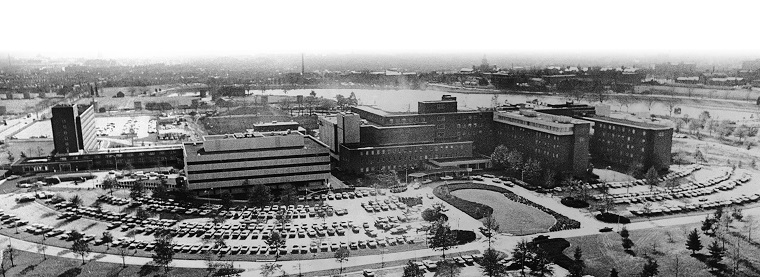Find care now
If you are experiencing a medical emergency, please call 911 or seek care at an emergency room.

Below are excerpts from Washington Hospital Center’s 25th Anniversary History, published in 1983 and called, “Building on Yesterday, Becoming Tomorrow”
Introduction:
“D.C. Hospital Center is a Dream Come True.” The Washington Star, September 2, 1956 (18 months before Washington Hospital Center opened)
When the Washington Hospital Center opened its doors in 1958, the vast red brick hospital on Irving Street not only marked a beginning, it also stood as a symbol of evolution and growth. The Center represented a merger of the experience and expertise of three of the city’s leading hospitals, whose roots in Washington reached back nearly 90 years. In this ultramodern setting, the hospital families from The Central Dispensary and Emergency Hospital, Garfield Memorial Hospital, and Episcopal Eye, Ear, and Throat Hospital would be able to pursue a long tradition of providing Washingtonians with fine medical care.
Day 1: Opening Day at Washington Hospital Center
At 8 a.m., March 10, 1958, a young Army couple expecting their third child was waiting. The red-haired, 24-year-old mother, the Hospital Center’s first patient, was whisked through admitting and into the labor room, and soon the loudspeaker system was announcing that the baby was due “momentarily.”
The message could be heard by the expectant father who was waiting in the hospital’s Stork Room along with a clutch of photographers and a number of well-wishers.
The loudspeaker kept promising “momentarily,” but the baby – like the Center itself – took a lot longer than anyone expected; it was not until 2:40 p.m. that the 7-pound, 3-ounce boy arrived.
By that time, the Center “had lost its deserted look,” The Washington Post reported. The first of the patients to be transferred from the merging hospitals, a Washington, D.C., woman recuperating from surgery, arrived in the Emergency Hospital ambulance at 8:30 a.m. And when the outpatient department opened at 9 a.m., about 15 people were waiting to be treated.
Through the day, patients continued to arrive, including three premature infants transferred from Garfield to the Center’s new nursery. In all, 36 patients were admitted.
The Crusade to Build Washington Hospital Center: 1943 to 1946
Overcrowding in Washington hospitals during World War II was severe. Persons with illnesses of every sort were mixed in together and space was so limited that beds were set up in sun parlors and halls…To further complicate matters, the war drained the city of doctors and nurses. Two out of every three physicians were in the service and those who remained often worked 14-hour days.
Spurred by patriotism, persons from all walks of life volunteered to help out, many in the evening after their regular working day was over. A lawyer worked at night in the basement of Emergency Hospital repairing frames used for traction; a custodian of the U.S. Senate ran the laundry service.
The hospitals’ shortcomings had not gone unnoticed by physicians, administrators and trustees. “But as reasonable men, these individuals recognized the short supply of labor, materials and money,” said Thomas Reynolds, treasurer of Emergency Hospital for 20 years. “And as reasonable men, they concluded that nothing could be done. Not so with the ladies.”
Specifically, two of the ladies to whom Mr. Reynolds was referring were Red Cross nurse’s aides, both married to senators: Eleanor Tydings and Elysabeth Barbour (who volunteered at Garfield and Emergency hospitals respectively). The two women were appalled at what they found – facilities that were outmoded and overcrowded. The two young women enlisted the help of a prominent and influential friend, Bessie Huidekoper…Using her home as a base of operations, the three women met informally with the presidents of most of the city’s voluntary hospitals and many leading doctors, and they set up a Hospital Center Committee.
(Led by these three passionate and inspiring women, the Hospital Center Act, which provided the federal funding to build a modern facility for the rapidly growing nation’s capital, was finally signed into law on August 8, 1946 by President Harry S Truman. Then, the complex work began to merge three hospitals, three medical staffs and thousands of employees, culminating in the opening of Washington Hospital Center in 1958.)
MedStar Washington Hospital Center Today: Facts at a Glance
From those early days to today, the Hospital Center has been leading the way in providing the most advanced care. Now a 912-bed major teaching and research hospital, it is among the 100 largest in the nation and renowned for handling the Washington region’s most complex cases. A pioneer in cardiovascular care, the hospital is home to MedStar Heart & Vascular Institute and literally thousands of Washingtonians and patients from around the country have received the highest level of heart and vascular care at the Hospital Center for the last 59 years. In addition, the Hospital Center operates the Washington region’s first Comprehensive Stroke Center and the District’s only Cardiac Ventricular Assist Device program, both certified by The Joint Commission. The hospital is also home to MedSTAR, a nationally verified level I trauma center with a state-of-the-art fleet of helicopters and ambulances and also operates the region’s only adult Burn Center. At a quick glance, here are some key hospital statistics from fiscal year 2016:
- 912 beds
- 5,933 employees
- 1,351 physicians
- 369 residents and fellows
- 36,816 inpatient admissions
- 390,047 outpatient visits
- 1,432 cancer admissions
- 66,695 cancer outpatient visits
- 1,733 cardiac surgeries
- 86,771 emergency department visits
- 2,551 MedSTAR Trauma admissions
- 11,884 inpatient surgeries
- 11,335 outpatient surgeries
- 3,564 births
- $17.7 million in charity care














